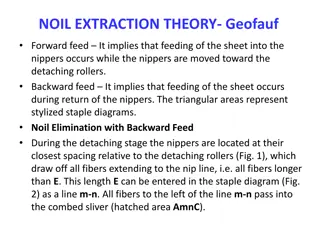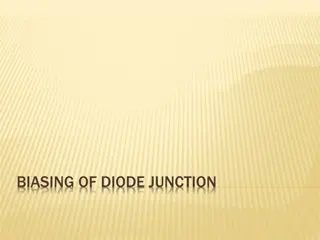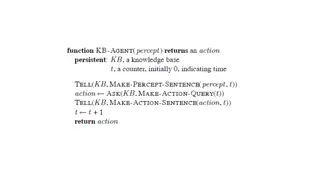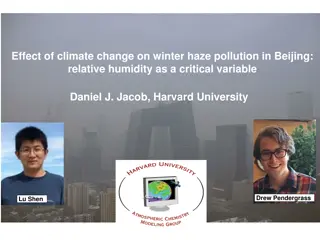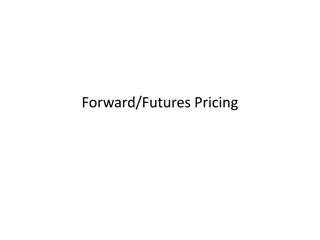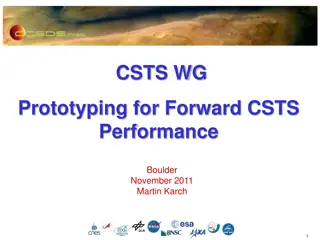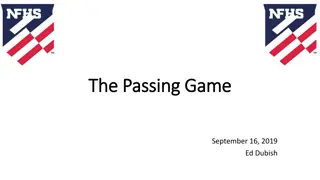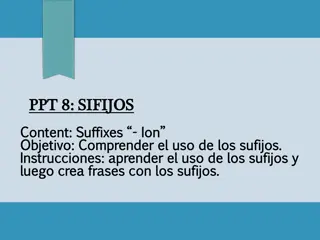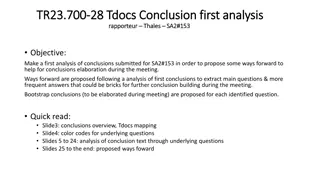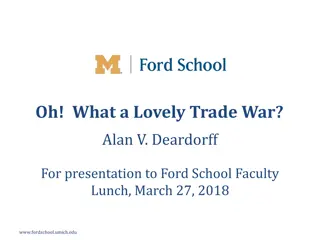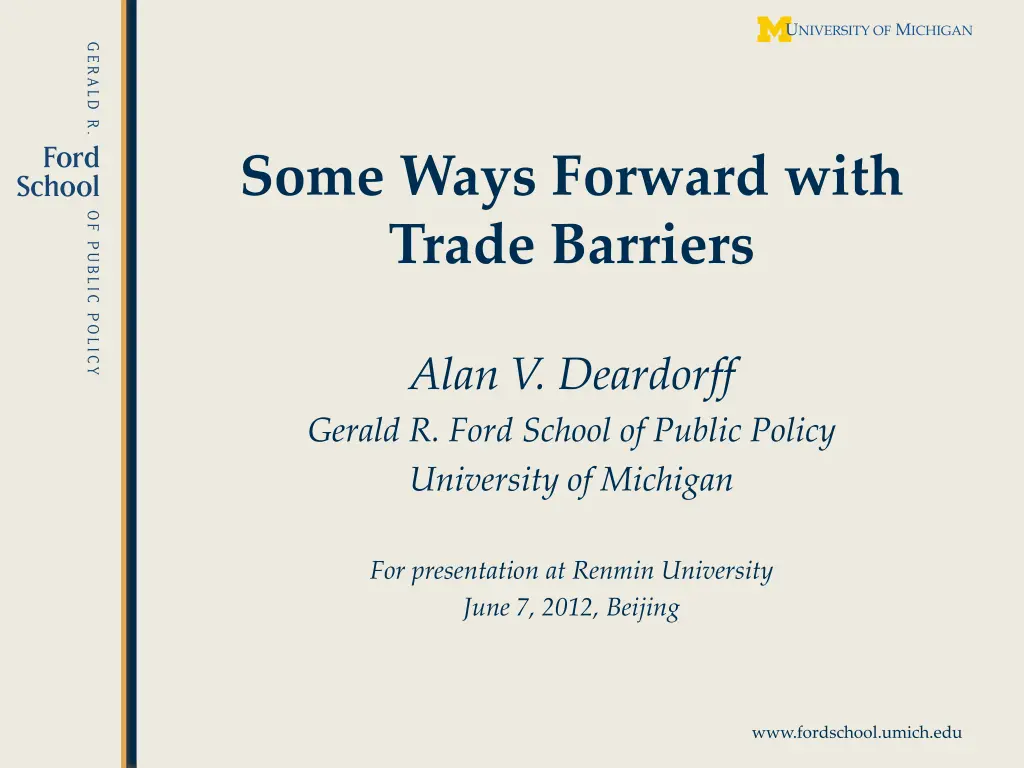
Evolution of Trade Barriers: Past, Present, and Future Trends
Explore the historical shifts in trade barriers over the past 70 years, from tariffs to nontariff measures and the impact of institutions like GATT and WTO. Learn about the challenges faced in recent trade agreements like the Doha Round and the rise of Free Trade Agreements and other policies influencing global trade dynamics.
Download Presentation

Please find below an Image/Link to download the presentation.
The content on the website is provided AS IS for your information and personal use only. It may not be sold, licensed, or shared on other websites without obtaining consent from the author. If you encounter any issues during the download, it is possible that the publisher has removed the file from their server.
You are allowed to download the files provided on this website for personal or commercial use, subject to the condition that they are used lawfully. All files are the property of their respective owners.
The content on the website is provided AS IS for your information and personal use only. It may not be sold, licensed, or shared on other websites without obtaining consent from the author.
E N D
Presentation Transcript
Some Ways Forward with Trade Barriers Alan V. Deardorff Gerald R. Ford School of Public Policy University of Michigan For presentation at Renmin University June 7, 2012, Beijing www.fordschool.umich.edu
Trends in Trade Barriers 70 years ago, trade barriers were mostly tariffs They had risen and fallen over the decades, and were high averaging perhaps 40% -- after the Great Depression Other barriers to trade, if they existed, were not noticed, in comparison with tariffs 2 www.fordschool.umich.edu
Trends in Trade Barriers At the end of WWII, the winning countries cooperated to create new institutions. IMF for exchange rates World Bank for economic development GATT for trade policies 3 www.fordschool.umich.edu
Trends in Trade Barriers Under GATT, tariffs were negotiated downward among the developed countries, in a series of Rounds. Tariffs among developed countries fell from 40% to 4% New rules began to be adopted to deal with a few nontariff barriers Developing countries Did not participate Eventually saw the wisdom of lowering tariffs unilaterally Their tariffs remain higher than developed countries 4 www.fordschool.umich.edu
Trends in Trade Barriers The last completed GATT Round, the Uruguay Round, created the WTO It includes many things All of the GATT Rules on traded services, GATS Rules on intellectual property protection, TRIPs Most important, WTO has an improved Dispute Settlement Mechanism, DSM Countries can files complaints and decisions are enforced Ultimate sanction is tariffs, but usually not needed 5 www.fordschool.umich.edu
Trends in Trade Barriers The Doha Round Begun in 2001, it has faltered and never been concluded Unclear what will happen, but probably nothing meaningful What has happened instead Proliferation of Free Trade Agreements, FTAs Increased use of nontariff measures, NTMs Nontariff barriers Other policies that affect trade (subsidies) 6 www.fordschool.umich.edu
Barriers Ill talk about Non-tariff barriers Protectionist Assistance Non-Protectionist Subsidies Tariffs, quotas, and tariff-rate-quotas 7 www.fordschool.umich.edu
NTMs and Developing Countries Note that NTMs may hurt developing countries more than tariffs Most developed-country tariffs are already low Many NTMs are hardest on low income countries 8 www.fordschool.umich.edu
My assumptions Multilateral trade negotiations won t succeed. Doha Round may end, with or without claimed success, but it will mean little. No new round will occur or accomplish anything in foreseeable future. 9 www.fordschool.umich.edu
My assumptions WTO will remain strong in spite of that, with Dispute Settlement Mechanism (DSM) functioning well. Proliferation of Free Trade Agreements (FTAs) will continue. 10 www.fordschool.umich.edu
Proliferation of FTAs Regional Trade Agreements (RTAs) Notified to GATT/WTO 11 www.fordschool.umich.edu
Issues to address What are the barriers? How are they best dealt with under these assumptions? 12 www.fordschool.umich.edu
Protectionist Policies Protectionist? Policies whose avowed purpose is to help domestic industries at expense of foreign Types Tariffs Import quotas Export subsidies Local content requirement Procurement requirement Exchange-rate devaluation 13 www.fordschool.umich.edu
Protectionist Policies How to deal with these? The GATT/WTO was designed to do some of this Tariff bindings Prohibitions 14 www.fordschool.umich.edu
Protectionist Policies Aside on VERs = Voluntary Export Restraints These were prohibited by WTO They may be coming back: Mar 20: Brazil persuaded Mexico to limit auto exports Apr 10: Mexico persuaded China to limit footwear exports, to avoid CVD Who will complain to the WTO? 15 www.fordschool.umich.edu
Assistance Policies Assistance? Policies whose avowed purpose is to help domestic industries Not explicitly at expense of foreign But often implicitly at their expense Types Domestic subsidies Bail-outs Intellectual property protection Resistance to exchange appreciation 16 www.fordschool.umich.edu
Assistance Policies How to deal with these? These are harder, as countries reserve the right to provide assistance Response is to permit other countries to offset any harm to them from these policies, when feasible E.g., Countervailing duties This is not always an option, especially for an exporter 17 www.fordschool.umich.edu
Non-protectionist Policies Non-protectionist? Avowed purpose is not to help domestic industries These claim benefit to Health of people, plants, animals Environment 18 www.fordschool.umich.edu
Non-protectionist Policies Health and safety examples Technical Barriers to keep out pests and disease Geographical indications Prohibition of genetically modified (GM) organisms Environment examples Tuna/dolphin; shrimp/turtle Carbon tariff 19 www.fordschool.umich.edu
Non-protectionist Policies Distinctive feature: Simply removing them is not optimal. That would sacrifice their claimed benefit to health, etc. Analysis and policy must quantify and respect these benefits, if legitimate. 20 www.fordschool.umich.edu
Non-protectionist Policies Challenges Evaluating the legitimacy of their non- protectionist purposes Identifying alternative less discriminatory policies for those purposes Separating and measuring their protectionist and non-protectionist effects 21 www.fordschool.umich.edu
Non-protectionist Policies Policy heterogeneity Trade is impacted when countries policies for the same purpose differ Differences may be accidental Different standards for the same purpose evolved out of different histories Trade could be facilitated by Harmonizing standards, or Mutual recognition (done recently for US and EU organic foods) 22 www.fordschool.umich.edu
Non-protectionist Policies Policy heterogeneity But differences may also reflect unequal in cost and benefits Low-income countries may choose lower standard due to cost. Such differences should be respected, not removed. 23 www.fordschool.umich.edu
Non-protectionist Policies My view No general methodology will suffice for all such NTMs. Each must be addressed on its own unique merits and demerits. This is already being done in the WTO DSM. 24 www.fordschool.umich.edu
Non-protectionist Policies My view DSM is not perfect, but it may be the best we can hope for. Especially for NTMs that arise anew. DSM is far better than we might have expected 25 www.fordschool.umich.edu
Non-protectionist Policies DSM Uses experts on the law Panel Appellate Body Takes evidence from both sides Should include experts on the substance of any policy Therefore DSM should be able to do a good job of handling the unique features of each case 26 www.fordschool.umich.edu
Non-protectionist Policies Other options for dealing with these? FTAs These can work well for Harmonizing technical standards Dealing with necessary standard heterogeneity Problem If FTAs center around US and EU, without FTA between US & EU, conflicts may persist between US- and EU-centered regimes This can be serious for developing countries Must they choose between US and EU? 27 www.fordschool.umich.edu
Non-protectionist Policies Other options Plurilateral agreements Issue-specific agreements, especially including both US and EU, hold promise. These work best if parties agree on fundamentals Preventing disease: Yes Avoiding GM foods: No These can provide the basis for resolving disputes, even involving non-members Once they set standards, non-members are likely to join. 28 www.fordschool.umich.edu
Subsidies Types On production On exports Effects of both: depress world prices Hurt foreign producers Help foreign consumers Nevertheless, they are mostly condemned except by beneficiaries (farmers) 29 www.fordschool.umich.edu
Subsidies Can they be ended through negotiations? Potentially yes, if negotiations are multilateral But that s unlikely, given state of Doha Round Certainly not, if negotiations are bilateral or regional with those harmed Unlike tariffs, subsidies cannot be removed with respect to only specific trading partners 30 www.fordschool.umich.edu
Subsidies Can they be ended unilaterally? Perhaps: Austerity makes subsidies an obvious target Domestic interests should push for agriculture to at least share in the austerity 31 www.fordschool.umich.edu
Subsidies Why not reduce them? The political power of farmers But perhaps they will be mollified if countries don t do it alone Need to seek coordinated reductions, outside of WTO, by EU, US, and Japan. Note: This will hurt some poor- country importers. Need to assist them. 32 www.fordschool.umich.edu
Tariffs, etc. Tariffs remain very high in agriculture and textiles/apparel. In agriculture, accompanied by quotas and tariff-rate-quotas. Note that tariff-rate-quotas can be made less harmful by either Expanding the quota Lowering the out-of-quota tariff Thus tariff reduction remains a very important objective. 33 www.fordschool.umich.edu
Tariffs, etc. That they are high: After Uruguay Round is implemented, agriculture and food processing sector will still have twice the average tariffs of textiles and clothing and nearly four times those for other manufactures. (Binswanger and Lutz 2000, drawing on Anderson et al. 1999) 34 www.fordschool.umich.edu
Tariffs, etc. How can they be reduced? Multilateral agreement? Not without Doha. Unilaterally? Not likely, given Power of protected (esp. farm) interests Budgetary implications 35 www.fordschool.umich.edu
Tariffs, etc. FTAs? Yes, but these only cut tariffs on FTA partners. Other disadvantages: Sensitive sectors often excluded. Tariffs outside remain high. Even inside, rules of origin (ROOs) may undermine the cuts. 36 www.fordschool.umich.edu
Tariffs, etc. A suggested alternative: Use FTAs to Damp the Tariff Bindings Specifically, countries should agree to: Reduce upper limit on all tariffs by the fraction of trade covered by FTAs As FTAs proliferate, limits on tariffs (tariff bindings) will fall, and eventually tariffs themselves will fall. 37 www.fordschool.umich.edu
Conclusions Non-tariff measures Protectionist Already covered by WTO Assistance Permit CVDs Non-Protectionist Leave to the WTO DSM. Negotiate in o FTAs o Plurilateral Agreements 38 www.fordschool.umich.edu
Conclusions Subsidies Leave to domestic forces for austerity. Tariffs, quotas, and tariff-rate-quotas Harness their reduction to the proliferation of FTAs, via Tariff Damping. 39 www.fordschool.umich.edu




